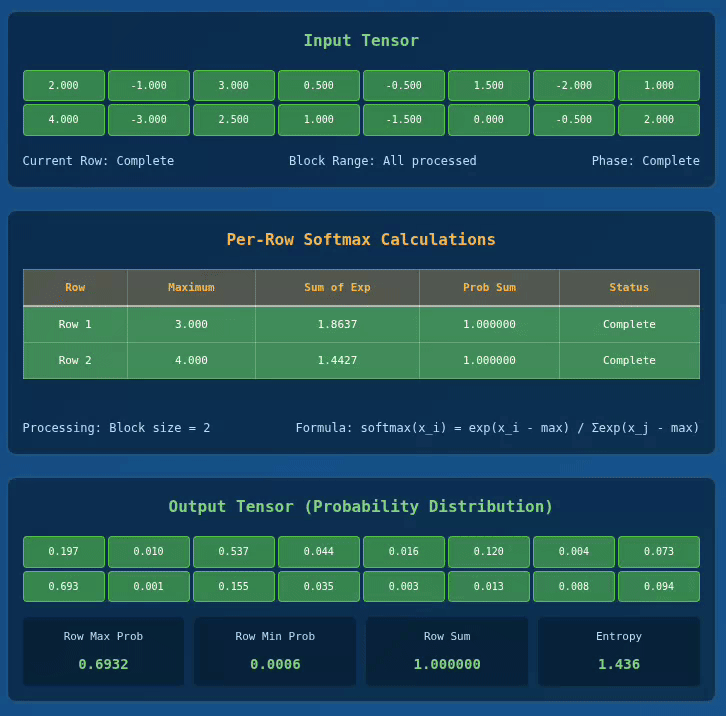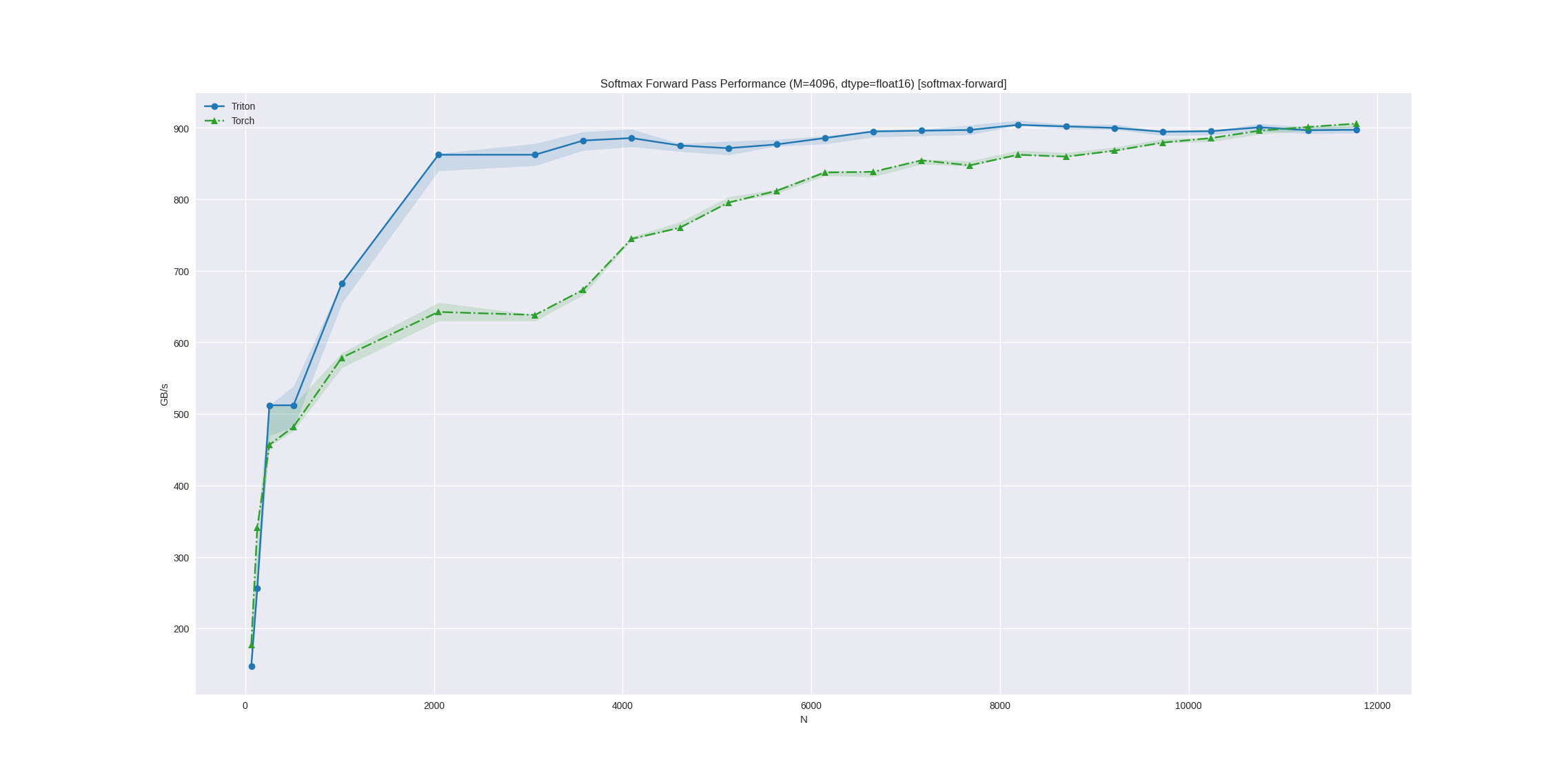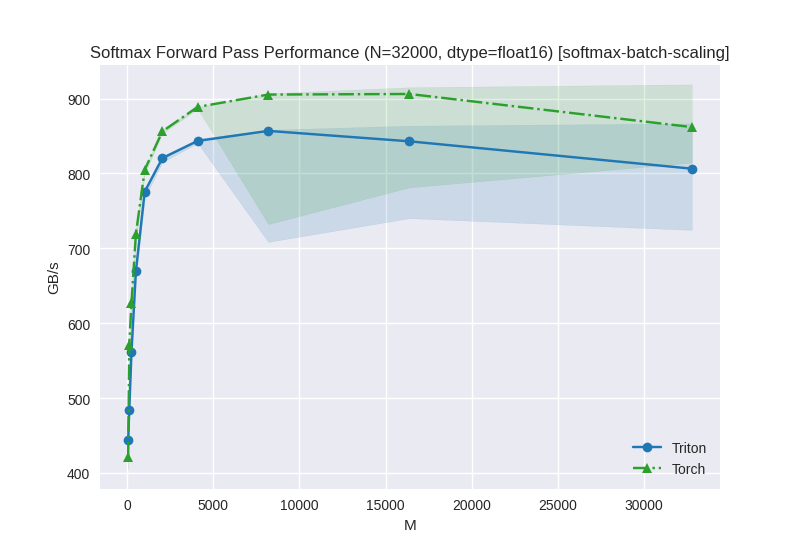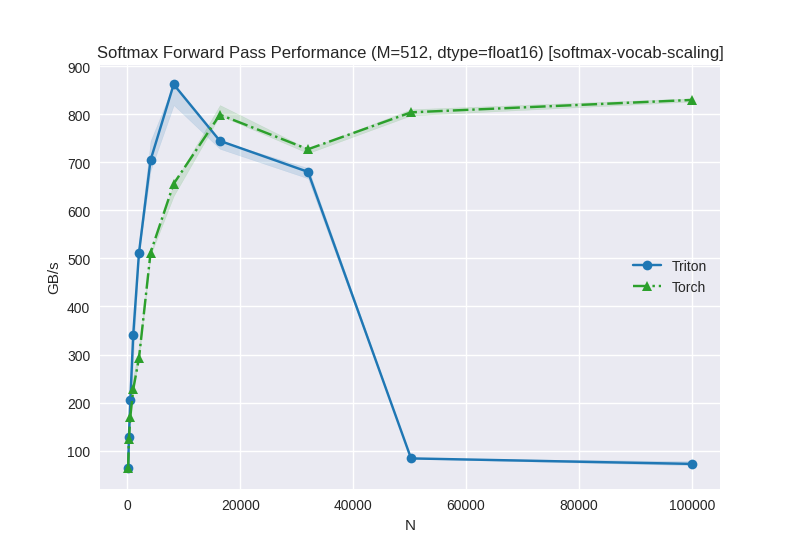Triton Kernels - Fused Softmax
Fused Softmax Triton kernel exploration
Softmax is one of the most fundamental operations in modern neural networks, particularly in attention mechanisms and classification layers. It’s especially critical in transformer architectures where it’s used extensively in self-attention computations. Unlike simple element-wise operations, softmax requires row-wise reductions (like RMSNorm), making it an excellent candidate for efficient Triton kernel implementation.
What is Softmax?
Softmax converts a vector of real numbers into a probability distribution. Each output element is in the range (0,1) and all elements sum to 1. The mathematical formula is:
\[\text{softmax}(x_i) = \frac{e^{x_i}}{\sum_{j=1}^{n} e^{x_j}}\]Where:
- $x_i$ is the $i$-th input element
- $n$ is the number of elements in the input vector
- The output is a probability distribution over $n$ classes
Numerical Stability in Softmax
A naive implementation of softmax can suffer from numerical overflow when dealing with large input values. The numerically stable version subtracts the maximum value from each element:
\[\text{softmax}(x_i) = \frac{e^{x_i - \max(x)}}{\sum_{j=1}^{n} e^{x_j - \max(x)}}\]This ensures that the largest exponent is 0, preventing overflow while maintaining mathematical equivalence.
Softmax Triton Kernel
Softmax shares similarities with RMSNorm in that it requires row-wise reductions followed by point-wise operations. The key differences are:
- Two reduction passes: Finding max, then computing sum of exponentials
- Exponential operations: More computationally expensive than squares
- Probability constraint: Output must sum to exactly 1.0
Let’s walk through a concrete example showing how softmax works in a Triton kernel with block-level processing:
Example Setup
Consider a 3×8 input matrix where each row needs independent softmax normalization with BLOCK_SIZE=4:
1
2
3
4
Input Matrix:
Row 0: [ 2.0, -1.0, 3.0, 0.5, -0.5, 1.5, -2.0, 1.0]
Row 1: [ 4.0, -3.0, 2.5, 1.0, -1.5, 0.0, -0.5, 2.0]
Row 2: [-1.0, 3.5, -2.5, 1.5, 0.0, -3.0, 2.5, -0.5]
Step 1: Program ID Mapping
Each Triton program (CUDA block) processes one row independently:
1
2
3
4
5
row_id = tl.program_id(0) # Each CUDA block processes one row
# Base pointers for this row
in_row_ptr = input_ptr + row_id * n_cols
out_row_ptr = output_ptr + row_id * n_cols
Block Assignment:
- Program 0: Processes Row 0
- Program 1: Processes Row 1
- Program 2: Processes Row 2
Step 2: Find Maximum Value (First Reduction)
With BLOCK_SIZE=4, each row is processed in 2 blocks to find the maximum:
Row 0 Processing (Program ID 0):
1
2
3
4
5
6
7
# Triton kernel code for finding max
row_max = -float('inf')
for start in range(0, n_cols, BLOCK_SIZE): # start = 0, then start = 4
cols = start + tl.arange(0, BLOCK_SIZE) # [0,1,2,3] then [4,5,6,7]
mask = cols < n_cols
vals = tl.load(in_row_ptr + cols, mask=mask, other=-float('inf'))
row_max = tl.maximum(row_max, tl.max(vals, axis=0))
| Block | Columns | Values | Block Max | Global Max |
|---|---|---|---|---|
| Block 1 | 0-3 | [2.0, -1.0, 3.0, 0.5] | 3.0 | 3.0 |
| Block 2 | 4-7 | [-0.5, 1.5, -2.0, 1.0] | 1.5 | 3.0 |
All Rows Maximum Summary:
| Row | Values | Maximum |
|---|---|---|
| Row 0 | [2.0, -1.0, 3.0, 0.5, -0.5, 1.5, -2.0, 1.0] | 3.0 |
| Row 1 | [4.0, -3.0, 2.5, 1.0, -1.5, 0.0, -0.5, 2.0] | 4.0 |
| Row 2 | [-1.0, 3.5, -2.5, 1.5, 0.0, -3.0, 2.5, -0.5] | 3.5 |
Step 3: Compute Sum of Exponentials (Second Reduction)
Now we compute $\sum e^{x_i - \max(x)}$ for numerical stability:
1
2
3
4
5
6
7
# Use the row_max found in previous step
row_sum = 0.0
for start in range(0, n_cols, BLOCK_SIZE):
cols = start + tl.arange(0, BLOCK_SIZE)
mask = cols < n_cols
vals = tl.load(in_row_ptr + cols, mask=mask, other=0.0)
row_sum += tl.sum(tl.exp(vals - row_max), axis=0)
Row 0 Exponential Sum (max = 3.0):
| Block | Original Values | Stable Values (x-max) | Exponentials | Block Sum |
|---|---|---|---|---|
| Block 1 | [2.0, -1.0, 3.0, 0.5] | [-1.0, -4.0, 0.0, -2.5] | [0.368, 0.018, 1.000, 0.082] | 1.468 |
| Block 2 | [-0.5, 1.5, -2.0, 1.0] | [-3.5, -1.5, -5.0, -2.0] | [0.030, 0.223, 0.007, 0.135] | 0.395 |
| Total Sum | 1.863 |
All Rows Exponential Sum Summary:
| Row | Maximum | Sum of Exponentials |
|---|---|---|
| Row 0 | 3.0 | 1.863 |
| Row 1 | 4.0 | 3.717 |
| Row 2 | 3.5 | 4.982 |
Step 4: Compute Softmax Output
Finally, we compute the softmax: $\frac{e^{x_i - \max(x)}}{\sum e^{x_j - \max(x)}}$
1
2
3
4
5
6
7
# Use the row_sum computed in previous step
for start in range(0, n_cols, BLOCK_SIZE):
cols = start + tl.arange(0, BLOCK_SIZE)
mask = cols < n_cols
vals = tl.load(in_row_ptr + cols, mask=mask, other=0.0)
out = tl.exp(vals - row_max) / row_sum # Compute softmax
tl.store(out_row_ptr + cols, out, mask=mask)
Row 0 Softmax Computation (row_max=3.0, row_sum=1.863):
| Block | Original Values | Stable Values (vals-row_max) | Exponentials | Softmax Output |
|---|---|---|---|---|
| Block 1 | [2.0, -1.0, 3.0, 0.5] | [-1.0, -4.0, 0.0, -2.5] | [0.368, 0.018, 1.000, 0.082] | [0.197, 0.010, 0.537, 0.044] |
| Block 2 | [-0.5, 1.5, -2.0, 1.0] | [-3.5, -1.5, -5.0, -2.0] | [0.030, 0.223, 0.007, 0.135] | [0.016, 0.120, 0.004, 0.072] |
Complete Output Matrix
After processing all rows:
1
2
3
4
Output Matrix (Softmax Applied):
Row 0: [0.197, 0.010, 0.537, 0.044, 0.016, 0.120, 0.004, 0.072] # Sum = 1.000
Row 1: [0.546, 0.001, 0.184, 0.041, 0.003, 0.015, 0.009, 0.110] # Sum = 1.000
Row 2: [0.012, 0.665, 0.003, 0.083, 0.030, 0.001, 0.203, 0.018] # Sum = 1.000
Softmax Kernel
The optimized softmax implementation uses a hybrid approach that automatically selects the best strategy based on the input size:
Two-Path Strategy
- Fast Path: When the entire row fits within
BLOCK_SIZE- single-pass computation - Tiled Path: When rows are larger than
BLOCK_SIZE- multi-pass block processing
This approach maximizes performance across different tensor sizes and hardware configurations.
1
2
3
4
5
6
7
8
9
10
11
12
13
14
15
16
17
18
19
20
21
22
23
24
25
26
27
28
29
30
31
32
33
34
35
36
37
38
39
40
41
42
43
44
45
46
47
48
49
50
51
52
53
54
55
56
57
58
59
60
import triton
import triton.language as tl
@triton.jit
def softmax_forward(
input_ptr, # pointer to [n_rows, n_cols]
output_ptr, # pointer to [n_rows, n_cols]
n_rows: tl.constexpr, # number of rows
n_cols: tl.constexpr, # number of columns (feature dim)
BLOCK_SIZE: tl.constexpr
):
row_id = tl.program_id(0)
# Base pointers for this row
in_row_ptr = input_ptr + row_id * n_cols
out_row_ptr = output_ptr + row_id * n_cols
# ---- Fast path: entire row fits in BLOCK_SIZE ----
if n_cols <= BLOCK_SIZE:
col_offsets = tl.arange(0, BLOCK_SIZE)
mask = col_offsets < n_cols
vals = tl.load(in_row_ptr + col_offsets, mask=mask, other=-float('inf')).to(tl.float32)
row_max = tl.max(vals, axis=0)
vals_stable = vals - row_max
numer = tl.exp(vals_stable)
denom = tl.sum(numer, axis=0)
out = numer / denom
tl.store(out_row_ptr + col_offsets, out, mask=mask)
return
# ---- Tiled path: handle rows larger than BLOCK_SIZE ----
# ==== Reduction Pass ====
# Pass 1: compute row max
row_max = -float('inf')
for start in range(0, n_cols, BLOCK_SIZE):
cols = start + tl.arange(0, BLOCK_SIZE)
mask = cols < n_cols
vals = tl.load(in_row_ptr + cols, mask=mask, other=-float('inf')).to(tl.float32)
row_max = tl.maximum(row_max, tl.max(vals, axis=0))
# ==== Reduction Pass ====
# Pass 2: compute exp-sum
row_sum = 0.0
for start in range(0, n_cols, BLOCK_SIZE):
cols = start + tl.arange(0, BLOCK_SIZE)
mask = cols < n_cols
vals = tl.load(in_row_ptr + cols, mask=mask, other=0.0).to(tl.float32)
row_sum += tl.sum(tl.exp(vals - row_max), axis=0)
# ==== Pointwise pass ====
# Pass 3: normalize + write
for start in range(0, n_cols, BLOCK_SIZE):
cols = start + tl.arange(0, BLOCK_SIZE)
mask = cols < n_cols
vals = tl.load(in_row_ptr + cols, mask=mask, other=0.0).to(tl.float32)
out = tl.exp(vals - row_max) / row_sum
tl.store(out_row_ptr + cols, out, mask=mask)
Fast Path (Small Rows)
For small feature dimensions (n_cols <= BLOCK_SIZE), we can load the entire row into registers and compute everything in a single pass:
1
2
3
4
5
6
7
8
9
10
11
12
13
14
# Fast path: entire row fits in BLOCK_SIZE
if n_cols <= BLOCK_SIZE:
col_offsets = tl.arange(0, BLOCK_SIZE)
mask = col_offsets < n_cols
vals = tl.load(in_row_ptr + col_offsets, mask=mask, other=-float('inf'))
row_max = tl.max(vals, axis=0) # Find maximum
vals_stable = vals - row_max # Numerical stability
numer = tl.exp(vals_stable) # Compute exponentials
denom = tl.sum(numer, axis=0) # Sum for normalization
out = numer / denom # Final softmax
tl.store(out_row_ptr + col_offsets, out, mask=mask)
return
Benefits of Fast Path:
- Single memory load: Data loaded once and kept in registers
- No redundant computation: All operations happen on cached data
- Optimal for small sequences: Common in many attention patterns
Tiled Path (Large Rows)
UPDATE (2025-09-24): On performance debugging, I later realized that the tiled path is never executed because I was always passing
BLOCK_SIZE = max(triton.next_power_of_2(n_cols), 64). FWIW, when I capped the BLOCK_SIZE, the kernel performance wasn’t great as soon we hit vocab dimension of >=1024. It seems to suggest that the block size strategy in the kernel is fine. Below, we still cover the tiled approach for demostration purposes.
For larger feature dimensions, we use the three-pass approach with block processing:
Pass 1: Find Row Maximum
1
2
3
4
5
6
row_max = -float('inf')
for start in range(0, n_cols, BLOCK_SIZE):
cols = start + tl.arange(0, BLOCK_SIZE)
mask = cols < n_cols
vals = tl.load(in_row_ptr + cols, mask=mask, other=-float('inf'))
row_max = tl.maximum(row_max, tl.max(vals, axis=0))
Pass 2: Compute Sum of Exponentials
1
2
3
4
5
6
row_sum = 0.0
for start in range(0, n_cols, BLOCK_SIZE):
cols = start + tl.arange(0, BLOCK_SIZE)
mask = cols < n_cols
vals = tl.load(in_row_ptr + cols, mask=mask, other=0.0)
row_sum += tl.sum(tl.exp(vals - row_max), axis=0)
Pass 3: Normalize and Store
1
2
3
4
5
6
for start in range(0, n_cols, BLOCK_SIZE):
cols = start + tl.arange(0, BLOCK_SIZE)
mask = cols < n_cols
vals = tl.load(in_row_ptr + cols, mask=mask, other=0.0)
out = tl.exp(vals - row_max) / row_sum
tl.store(out_row_ptr + cols, out, mask=mask)
Benefits of Tiled Path:
- Memory efficiency: Handles arbitrarily large sequences
- Numerical stability: Consistent max subtraction across all blocks
- Parallelizable: Each block can be processed independently within each pass
Let’s see it in action
Below we have a visualization for 2 x 8 Tensor with BLOCK_SIZE = 2:
Interactive Softmax Visualizer
Explore how Softmax activation works in Triton kernels with this interactive visualization:
🎯 Softmax Activation Triton Kernel Visualization
| Row | Maximum | Sum of Exp | Prob Sum | Status |
|---|
Optimization and Numeric Strategies
Memory Access Patterns
Softmax kernels benefit from several optimization strategies:
- Coalesced Memory Access: Ensure consecutive threads access consecutive memory locations
- Shared Memory Usage: Store intermediate results in shared memory for reuse
- Register Blocking: Minimize memory traffic by keeping frequently accessed data in registers
Numerical Precision
1
2
3
4
# High-precision accumulation for better numerical stability
_sum = tl.zeros([BLOCK_SIZE], dtype=tl.float64) # Use double precision for sum
# ... accumulate in double precision ...
sum_exp = tl.sum(_sum, axis=0).to(tl.float32) # Convert back for final computation
Fusion Opportunities
Softmax is often fused with other operations:
1
2
3
4
5
6
7
8
9
10
11
12
13
14
15
16
17
18
19
# Fused Softmax + Cross-Entropy Loss
@triton.jit
def softmax_cross_entropy_fused(
logits_ptr, targets_ptr, loss_ptr,
row_stride, feature_dim, BLOCK_SIZE: tl.constexpr
):
# Compute softmax and cross-entropy in a single kernel
# Saves memory bandwidth by avoiding intermediate softmax storage
pass
# Fused Attention Softmax
@triton.jit
def attention_softmax_fused(
query_ptr, key_ptr, value_ptr, output_ptr,
seq_len, head_dim, BLOCK_SIZE: tl.constexpr
):
# Compute Q@K^T, apply softmax, then multiply by V
# Reduces memory traffic in attention computation
pass
Typical Use Cases
Softmax is critical in several key areas:
1. Attention Mechanisms
1
2
3
4
# Scaled Dot-Product Attention
attention_scores = Q @ K.T / sqrt(d_k)
attention_weights = softmax(attention_scores) # Softmax over sequence dimension
output = attention_weights @ V
2. Classification Layers
1
2
3
4
# Multi-class classification
logits = model(input)
probabilities = softmax(logits) # Convert to probability distribution
predicted_class = argmax(probabilities)
3. Language Model Sampling
1
2
3
4
# Temperature-scaled softmax for text generation
scaled_logits = logits / temperature
probabilities = softmax(scaled_logits)
next_token = sample(probabilities)
Benchmarks
Let’s see triton benchmarks with our softmax kernel implementation compared to PyTorch:
The benchmark shows our Triton implementation achieving competitive performance with PyTorch’s optimized kernels for small batches.
Looking at this benchmark data, we can see that for larger vocabulary sizes (N > ~1024), Triton performance plateaus around 870-900 GB/s while PyTorch continues to scale, reaching similar performance levels at the highest vocabulary sizes.
For vocabulary scaling, Triton outperforms PyTorch at medium sizes (512-8192) but shows significant performance degradation at very large vocabularies (32K+), while PyTorch maintains consistent throughput across all vocabulary sizes.
Perf Debugging
I created a sample script to now look at each implementation separately to see what are the bottlenecks in the triton kernel for batch size and vocab scaling.
1
2
3
4
5
6
7
8
9
10
11
12
13
14
15
16
17
18
19
20
21
22
23
24
25
26
27
28
29
30
31
32
33
34
35
36
37
38
39
40
41
42
43
44
45
46
47
48
49
50
51
52
53
54
55
56
57
58
59
60
61
62
63
64
65
66
67
68
69
70
71
72
73
74
75
76
77
78
79
80
81
82
83
84
85
86
87
88
89
90
91
92
93
94
95
96
97
98
99
100
101
102
103
104
105
106
107
108
109
110
111
112
113
114
115
116
117
118
119
120
121
122
123
124
125
126
127
128
129
130
131
132
133
134
135
136
137
138
139
140
141
142
143
144
145
146
147
148
149
150
151
152
153
#!/usr/bin/env python3
import sys
import torch
import click
from loguru import logger
# Import the existing softmax kernel
from kernels.softmax import softmax
# Ensure CUDA is available
if not torch.cuda.is_available():
logger.error("CUDA is not available. This script requires a CUDA-capable GPU.")
sys.exit(1)
DEVICE = torch.device("cuda")
def benchmark_softmax(
M, N, dtype=torch.float16, warmup_iters=10, bench_iters=100, backend="triton"
):
"""
Benchmark softmax kernel with specific M and N values.
Args:
M: Number of rows (batch dimension)
N: Number of columns (feature dimension)
dtype: Data type for tensors
warmup_iters: Number of warmup iterations
bench_iters: Number of benchmark iterations
backend: Either "triton" or "torch"
"""
logger.info(f"Benchmarking {backend} softmax with M={M}, N={N}, dtype={dtype}")
# Create input tensor
x = torch.randn(M, N, dtype=dtype, device=DEVICE) * 2.0
# Select softmax function
if backend == "triton":
softmax_fn = softmax
elif backend == "torch":
softmax_fn = lambda x: torch.nn.functional.softmax(x, dim=-1)
else:
raise ValueError(f"Unknown backend: {backend}")
# Warmup
logger.info(f"Warming up for {warmup_iters} iterations...")
for _ in range(warmup_iters):
_ = softmax_fn(x)
torch.cuda.synchronize()
# Benchmark
logger.info(f"Running benchmark for {bench_iters} iterations...")
# Collect individual timings for noise reduction
times_ms = []
for _ in range(bench_iters):
torch.cuda.synchronize()
start_event = torch.cuda.Event(enable_timing=True)
end_event = torch.cuda.Event(enable_timing=True)
start_event.record()
output = softmax_fn(x)
end_event.record()
torch.cuda.synchronize()
times_ms.append(start_event.elapsed_time(end_event))
# Remove top and bottom 10% to reduce noise
times_ms.sort()
n_remove = int(0.1 * len(times_ms))
if n_remove > 0:
trimmed_times = times_ms[n_remove:-n_remove]
logger.info(f"Trimmed {n_remove} outliers from each end ({2*n_remove} total)")
else:
trimmed_times = times_ms
avg_time_ms = sum(trimmed_times) / len(trimmed_times)
# Calculate metrics
num_elements = M * N
bytes_accessed = 2 * num_elements * x.element_size() # input + output
bandwidth_gbps = (bytes_accessed * 1e-9) / (avg_time_ms * 1e-3)
logger.success(f"Benchmark completed:")
logger.info(f" Average time per iteration: {avg_time_ms:.4f} ms")
logger.info(f" Bandwidth: {bandwidth_gbps:.2f} GB/s")
logger.info(f" Total elements: {num_elements:,}")
logger.info(f" Memory accessed: {bytes_accessed / 1e9:.2f} GB")
return output, avg_time_ms, bandwidth_gbps
@click.command()
@click.option("--M", type=int, required=True, help="Number of rows (batch dimension)")
@click.option(
"--N", type=int, required=True, help="Number of columns (feature dimension)"
)
@click.option(
"--backend",
type=click.Choice(["triton", "torch"]),
default="triton",
help="Backend to use: triton (custom kernel) or torch (PyTorch)",
)
@click.option(
"--dtype",
type=click.Choice(["float16", "float32"]),
default="float16",
help="Data type for tensors",
)
@click.option("--warmup", type=int, default=10, help="Number of warmup iterations")
@click.option("--iters", type=int, default=100, help="Number of benchmark iterations")
@click.option(
"--profile-only", is_flag=True, help="Run only a single iteration for profiling"
)
def main(m, n, backend, dtype, warmup, iters, profile_only):
"""Benchmark softmax kernel for ncu profiling."""
# Convert dtype string to torch dtype
dtype_map = {"float16": torch.float16, "float32": torch.float32}
dtype_tensor = dtype_map[dtype]
logger.info(f"Starting {backend} softmax benchmark with parameters:")
logger.info(f" Backend: {backend}")
logger.info(f" M (rows): {m}")
logger.info(f" N (cols): {n}")
logger.info(f" dtype: {dtype}")
logger.info(f" warmup iterations: {warmup}")
logger.info(f" benchmark iterations: {iters}")
if profile_only:
logger.info("Profile-only mode: running single iteration for ncu profiling")
x = torch.randn(m, n, dtype=dtype_tensor, device=DEVICE) * 2.0
if backend == "triton":
output = softmax(x)
else: # torch
output = torch.nn.functional.softmax(x, dim=-1)
torch.cuda.synchronize()
logger.success("Single iteration completed for profiling")
else:
# Run full benchmark
output, avg_time_ms, bandwidth_gbps = benchmark_softmax(
m, n, dtype_tensor, warmup, iters, backend
)
logger.success("Benchmark completed successfully!")
if __name__ == "__main__":
main()
Repro
1
2
3
4
5
6
7
8
9
10
11
12
13
14
15
16
17
18
19
20
21
22
23
24
25
26
27
28
29
30
31
32
33
34
35
36
37
38
$ python softmax_benchmark.py --M 8192 --N 32000 --iters 1000 --backend torch
2025-09-19 10:46:09.523 | INFO | __main__:main:127 - Starting torch softmax benchmark with parameters:
2025-09-19 10:46:09.523 | INFO | __main__:main:128 - Backend: torch
2025-09-19 10:46:09.523 | INFO | __main__:main:129 - M (rows): 8192
2025-09-19 10:46:09.523 | INFO | __main__:main:130 - N (cols): 32000
2025-09-19 10:46:09.523 | INFO | __main__:main:131 - dtype: float16
2025-09-19 10:46:09.523 | INFO | __main__:main:132 - warmup iterations: 10
2025-09-19 10:46:09.523 | INFO | __main__:main:133 - benchmark iterations: 1000
2025-09-19 10:46:09.524 | INFO | __main__:benchmark_softmax:36 - Benchmarking torch softmax with M=8192, N=32000, dtype=torch.float16
2025-09-19 10:46:09.588 | INFO | __main__:benchmark_softmax:50 - Warming up for 10 iterations...
2025-09-19 10:46:09.613 | INFO | __main__:benchmark_softmax:56 - Running benchmark for 1000 iterations...
2025-09-19 10:46:10.812 | INFO | __main__:benchmark_softmax:78 - Trimmed 100 outliers from each end (200 total)
2025-09-19 10:46:10.812 | SUCCESS | __main__:benchmark_softmax:89 - Benchmark completed:
2025-09-19 10:46:10.812 | INFO | __main__:benchmark_softmax:90 - Average time per iteration: 1.1638 ms
2025-09-19 10:46:10.812 | INFO | __main__:benchmark_softmax:91 - Bandwidth: 901.02 GB/s
2025-09-19 10:46:10.812 | INFO | __main__:benchmark_softmax:92 - Total elements: 262,144,000
2025-09-19 10:46:10.812 | INFO | __main__:benchmark_softmax:93 - Memory accessed: 1.05 GB
2025-09-19 10:46:10.812 | SUCCESS | __main__:main:152 - Benchmark completed successfully!
$ python softmax_benchmark.py --M 8192 --N 32000 --iters 1000 --backend triton
2025-09-19 10:46:17.670 | INFO | __main__:main:127 - Starting triton softmax benchmark with parameters:
2025-09-19 10:46:17.671 | INFO | __main__:main:128 - Backend: triton
2025-09-19 10:46:17.671 | INFO | __main__:main:129 - M (rows): 8192
2025-09-19 10:46:17.671 | INFO | __main__:main:130 - N (cols): 32000
2025-09-19 10:46:17.671 | INFO | __main__:main:131 - dtype: float16
2025-09-19 10:46:17.671 | INFO | __main__:main:132 - warmup iterations: 10
2025-09-19 10:46:17.671 | INFO | __main__:main:133 - benchmark iterations: 1000
2025-09-19 10:46:17.671 | INFO | __main__:benchmark_softmax:36 - Benchmarking triton softmax with M=8192, N=32000, dtype=torch.float16
2025-09-19 10:46:17.742 | INFO | __main__:benchmark_softmax:50 - Warming up for 10 iterations...
2025-09-19 10:46:17.932 | INFO | __main__:benchmark_softmax:56 - Running benchmark for 1000 iterations...
2025-09-19 10:46:19.172 | INFO | __main__:benchmark_softmax:78 - Trimmed 100 outliers from each end (200 total)
2025-09-19 10:46:19.172 | SUCCESS | __main__:benchmark_softmax:89 - Benchmark completed:
2025-09-19 10:46:19.172 | INFO | __main__:benchmark_softmax:90 - Average time per iteration: 1.2150 ms
2025-09-19 10:46:19.172 | INFO | __main__:benchmark_softmax:91 - Bandwidth: 863.02 GB/s
2025-09-19 10:46:19.172 | INFO | __main__:benchmark_softmax:92 - Total elements: 262,144,000
2025-09-19 10:46:19.172 | INFO | __main__:benchmark_softmax:93 - Memory accessed: 1.05 GB
2025-09-19 10:46:19.172 | SUCCESS | __main__:main:152 - Benchmark completed successfully!
Great! we can repro the difference in memory bandwidth – let’s run the torch and triton versions in ncu.
Triton
Torch
Torch version seems to be calling the cunn_SoftMaxForward kernel under the hood. Seems like there is some discussion on this in a github issue below.
Softmax kernel performance degradation at large vocabulary sizes #144645
PyTorch performance investigation related to the benchmark results shown above
Update (I missed this originally)
After looking a little closer at the profile, I noticed that the
BLOCK_SIZEwas automatically changed to 128 in case of the triton kernel versus 1024 for Torch. It seems that triton is autotuning the hard CUDA block size instead of using the logical BLOCK_SIZE that is provided in the kernel.
In addition, when I look at the official tutorial on softmax, they do some shenanigans with the num_warps and warmup.
Summary
In this exploration, I implemented a Triton softmax kernel using a hybrid approach with fast and tiled paths. The kernel achieves competitive performance with PyTorch at small-to-medium vocabulary sizes but shows degradation at very large vocabularies (32K+). Key findings:
- Fast path optimization for small sequences (≤ BLOCK_SIZE) enables single-pass computation
- Numerical stability maintained through max subtraction across all implementations
- Performance trade-offs: Triton excels at medium sizes (512-8192) but PyTorch scales better for large vocabularies






